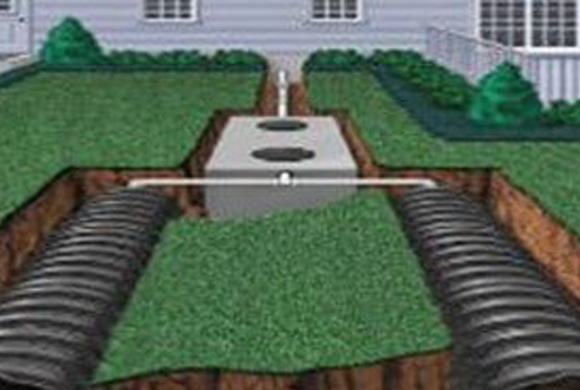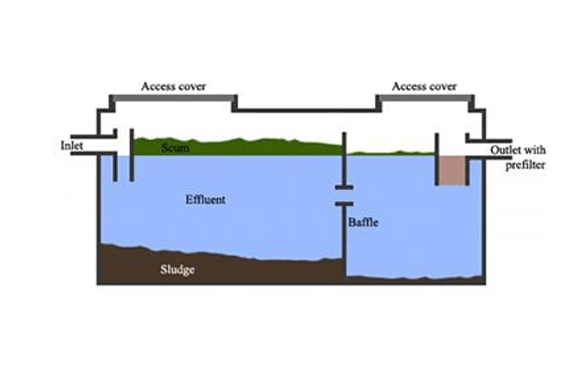Septic Tanks & Systems Residential or Commercial
Proudly Serving Okaloosa, Walton, and Santa Rosa County
How does a septic tank work?
The septic tank is a large holding tank that is most commonly made from precast concrete. Everything flows into the tank through the inlet line. Here, the bacteria that live in the tank break down the waste and it separates. Three layers form in the middle section of the tank. Organic solids form a crusty layer of "scum" at the surface of the tank. Inorganic solids form a layer of "sludge" at the bottom. The main purpose of the septic tank is to provide a place for all the solid wastes that leave your house to accumulate and be filtered. Here the solid waste can be dealt with by pumping them out of your system. If the solids are not removed from the system, then the solid layers thicken and the "clear water" middle layer will be contaminated with solids, which will then leave the outlet baffle and flow into the drainage system.
Why is it necessary to pump a septic tank?
The importance of maintaining your septic system can be compared to the importance of maintaining your car's engine. The responsible automobile owner knows that the car's oil should be changed every few thousand miles. If you do not change your car's oil periodically, your car's engine will eventually fail. The same holds true for your septic system. Pumping your septic tank is the most important aspect of maintaining your septic system. Most septic systems should be pumped out every 2 or 3 years depending on the size of the tank and the number of people using the system. (In some cases when a large number of people are using a small tank, the tank needs to be pumped annually or semiannually.) If the septic tank is neglected, solid waste will escape from the septic tank into the drainage system.
The solids will plug up the following:
- The perforations in the leach lines
- The gravel in the trenches
- Eventually, the soil itself. Once the drainage system is contaminated with solids, it will fail.
What areas do we service?
Okaloosa County
- Crestview
- Baker
- Holt
- Laurel Hill
- Niceville
- Valparaiso
- Ocean City
- Okaloosa Island
- Valparaiso
- Mary Esther
- Destin
- Cinco Bayou
- Shalimar
- Blackman
- Seminole
- Mary Esther
- Destin
- Cinco Bayou
- Shalimar
- Blackman
- Campton
- Wright
- Campton
- Deerland
- Escambia Farms
- Garden City
- Ft. Walton Beach
- Milligan
- Villa Tasso
Walton County
- DeFuniak Springs
- Freeport
- Paxton
- Argyle
- Bruce
- Grayton Beach
- Miramar Beach
- Mossy Head
- Santa Rosa Beach
- Seaside
Santa Rosa County
- Gulf Breeze
- Milton
- Pace
- Bagdad
- Holley
- Harold
- Munson
- Navarre
- Navarre Beach
- Oriole Beach
- Whiting Field
Was my tank full?
This is a difficult question to answer. It is like asking the mechanic who changes the oil in your car "was the oil dirty?", or when you empty the vacuum cleaner bag in your home "was it full?". Most of the time the answer is "Yes". The absolute best way to know when to have your tank pumped is by how long it has been since it was last pumped. NO SEPTIC TANK SHOULD GO LONGER THAN FIVE YEARS BETWEEN CLEANINGS!!
Does your company offer any discounts?
We currently offer two types of discounts that cannot be combined. First, we offer a military discount of $10 off your septic tank pumping for all active duty and/or retired military personnel. Second, we offer a “good neighbor discount”. Basically, if you have a neighbor less than a mile away that is willing to get their tank pumped on the same day & time as you, we offer $25 off each septic tank pumping; that means $25 off to you & $25 off for your neighbor!
How should I properly maintain my system?
Here are nine simple steps that the US EPA suggests in order to keep your septic system working, with additional comments added by an experienced septic system inspector.
- Locate your septic tank and drainfield. Keep a drawing of these locations in your records.
- Have your septic system pumped and inspected at least once every three years.
- Don't dispose of household hazardous wastes (paint thinner, paint, oil, gasoline, etc.) in sinks or toilets.
- Keep other household items out of your system (diapers, baby wipes, wrappers, feminine products, cigarette butts, garbage of any kind).
- Use water efficiently. Reducing water usage reduces the load on your drainfield.
- Plant only grass over and near your septic system. Roots from nearby trees or shrubs might clog and damage the system. Also, do not apply manure or fertilizers over the drainfield.
- Keep vehicles and livestock off your septic system. The weight can damage the pipes and tank, and your system may not drain properly under compacted soil.
- Keep gutters and basement sump pumps from draining into or near your septic system. And very important, keep surface runoff and subsurface runoff away from the septic tank and drainfield.
- Check with your septic contractor before using additives. Commercial septic tank additives do not eliminate the need for periodic pumping and can be harmful to your system.
How much does it cost to get my septic tank pumped?
Pricing depends upon location. Call for a free quote.
What drain field product do you use for installations and repairs?
We use ARC 24 chambers.
Where is my septic tank?
There are some standard "rules of thumb" for septic tank location. These "rules of thumb" do not always hold true, but they provide a good place to start. If your home has a basement, you can look at the wastewater drain pipes and see where the main "soil pipe" exits the house through the basement wall (some homes have more than one "soil pipe" exiting through the wall). This usually indicates that you have more than one tank at your home (possibly a septic tank and a separate gray water tank). When you locate the place where your soil pipe exits the home, note the depth of it below the grade of the ground outside. This gives an indication of how deep the septic tank will be buried in the yard. Next, measure from the soil pipe to something you can see outside (like a window, water spigot pipe, dryer vent, or basement corner). The rule of thumb is that the soil pipe will point straight to the septic tank outside the wall. Also, the tank is usually 10 feet off the foundation wall outside, and the top of the tank is usually less than one foot deep. Next, using a metal probe, probe down into the ground in the yard space where you expect the tank to be. Sometimes, you can see the outline of the tank in the lawn. The grass may be a slightly different color, or you may see slight depressions where the ground has settled around the edges of the tank or where the cleanout cover(s) have been dug up in the past. You are looking for a structure (usually concrete, sometimes plastic or metal) that is typically 8 feet long and 5 feet wide. Sometimes these rules of thumb do not hold true. The pipe may turn on the way to your septic tank; the tank may be closer to the foundation wall or sometimes much further than the standard 10 feet; sometimes the tank is buried deeper than the standard 6" to 12". We have seen situations where a lot of fill dirt was placed over the tank after it was installed. Sometimes people mistakenly put landscaping, driveways, sidewalks, trees, bushes, decks, sheds, garages, swimming pools, or, yes, even entire additions over the top of the septic tank. Sometimes the home does not have a basement, or the soil pipe goes down into the basement floor, rather than out through the wall. These situations always present a challenge, but we will overcome the challenge...we will find the tank at no additional charge!
Where is my septic tank?
There are many different types and styles of septic tanks. Older tanks are usually single compartment tanks. This means that the entire tank can be pumped through one cleanout cover. The cleanout cover is usually in the center of the tank and is between 12" and 30" in diameter. Other septic tanks can have three covers on the top: an inlet cover over the inlet baffle where the pipe comes in from the house; a center cleanout cover; and an outlet cover over the outlet baffle where the pipe runs out to the leaching system. Some tanks, however, have the large cleanout cover at the front of the tank; others have it at the rear of the tank. Newer tanks have two compartments. This means that the center cleanout cover and the outlet cover need to be accessed to clean the tank out thoroughly. Newer tanks are often equipped with an effluent filter in the outlet baffle also. This filter needs to be removed, rinsed off with a garden hose, and put back in place every time the tank is pumped. For standard septic tank pumping maintenance, only the cleanout cover(s) need to be dug up. If you are experiencing a back-up problem in your toilets or other drains, then the inlet cover will need to be dug up also so that the inlet baffle can be unplugged and/or the inlet pipe can be snaked. Always leave a garden hose available for us to use to rinse things out whenever possible.
When can you pump my tank? Does someone need to be home?
We schedule septic tank pumping appointments from 8AM to 5PM Monday through Friday. We can usually narrow it down to a 2-hour appointment window, but it is difficult to give an exact time because we never know exactly how long the truck will be at a particular stop. We completely understand how busy everyone is these days and we appreciate how valuable your time is. We can perform standard pumping maintenance when no one is home; particularly if your tank is dug up or we have been to your home before and have measurements to the cover(s). If you are experiencing a backup situation in your toilets or other drains, someone should be home so that we can have you flush the toilets after we are done to make sure that everything is flowing properly.
What about payment?
We need to collect payment at the time of the pumping service. If someone is home, our drivers can be paid with cash, check, or credit card. If no one will be home, customers will sometimes leave a check in an agreed upon location and we will leave an invoice in its place when we are done. For your convenience, we can also process your payment with a Visa, MasterCard, or Discover card over the phone.
Was my tank full?
This is a difficult question to answer. It is like asking the mechanic who changes the oil in our car "was the oil dirty?", or when you empty the vacuum cleaner bag in your home "was it full?". Most of the time the answer is "Yes". The absolute best way to know when to have your tank pumped is by how long it has been since it was last pumped. NO SEPTIC TANK SHOULD GO LONGER THAN THREE YEARS BETWEEN CLEANINGS!!
I know someone who hasn't had their tank pumped in 10 years!?
There is no law mandating that every homeowner with a septic system get his or her tank pumped every 2-3 years (although the subject has been broached on many occasions for environmental reasons). Just as it is your responsibility to change the oil in your car, change your vacuum cleaner bag, mow your lawn, etc.; it is your responsibility to get your tank pumped every 2-3 years. If you do not get your tank pumped every 2-3 years, you are headed for disaster. People who neglect to have the tank pumped on a regular basis are usually the people who call when they have a major problem. And getting your tank pumped when you have a failure in your leaching system is like getting your oil changed after your car's engine starts making a loud knocking noise... Too late! There is no way to avoid costly, inconvenient repairs at that point. AN OUNCE OF PREVENTION IS WORTH A POUND OF CURE! The homeowner who neglected to pump his tank always wishes that they could turn back the clock and get that done when they are faced with an extensive, expensive replacement situation. Also, the type of system you will need in the case of a leaching failure may be more elaborate and expensive than the system you currently have. If you contact your local County Public Health Department, they will tell you that the septic tank should be pumped every 2-3 years.
My septic tank is very deep. What can I do to avoid so much digging every time my tank is pumped?
When you call to get your tank pumped, ask to have your tank measured up for a "riser". A riser is an extension (picture a donut made of concrete or heavy plastic) that your cleanout cover sits on top of, closer to the ground surface. Because there are many types, sizes, and shapes of covers; at widely varying depths, the type of riser you need may vary. The best time to put a riser on your tank is while your tank is dug up.
I will be selling my home at some point in the future. What should I do to be sure that there will not be an issue with my septic system at that time?
The best thing you can do is have Zeb Watts Septic pump your tank every 2-3 years. The record of the service history of your tank can be included in the Septic Inspection Report that will be required when you are ready to sell your home. When your tank is serviced regularly, we will let you know if we observe any issues or problems that need to be addressed when your tank is pumped. Nothing puts a homebuyer at ease in relation to the septic system more than a thorough and complete service history report.
Do you offer service all year round?
Yes! We will gladly pump your septic tank any time you need it. Our trucks are on the road in the spring, summer, fall, and winter; in the sunshine or rain.
What is an outlet device? Is it important?
All septic tanks must be equipped an outlet device. The outlet device is perhaps the most important component in your entire septic system. The outlet device acts like a "splash guard" around the outlet pipe. Extending down into the "middle layer" in the septic tank, it allows only the "clear effluent" from the middle layer to run out of the outlet pipe to the leaching system. It does not extend down far enough for the bottom "sludge" layer to escape, and it stops the "scum" layer at the top of the tank from being rinsed out the outlet pipe. Unfortunately, these devices sometimes fall off in the septic tank, sinking to the bottom where they are completely useless. This is another reason why you need to have the tank pumped every 2-3 years to check your outlet device. If it is off in your septic tank, it needs to be replaced immediately (before the septic tank fills back up to operating level which typically takes between a few days to a week) if possible. If we notice a problem with your outlet device when we pump your tank, we will let you know. If you ever see a note on your invoice that your outlet device is off, you should make arrangements to have it fixed ASAP!
What does it mean if I have a "high H2O level" in my septic tank?
A high H2O level in the septic tank means that the water level is up over the normal operating level, which is the invert (bottom) of the outlet pipe. This means that the effluent is not getting out of the tank as well as it should and you have a leaching problem. The first question at this point should be: has there been some unusual spike in the water usage in your home? We sometimes find that a drain may be running in the house. The biggest culprit here is the toilet. If you have a toilet running unnecessarily it can send an enormous amount of water into the septic system unnecessarily. This can easily overload the system and lead to premature failure. If your toilets are running, this must be fixed immediately. If the water usage in your home is normal, your problem is beyond the septic tank. You may have a problem with the outlet pipe, the distribution box, or the leach lines themselves. You can hire us to do some trouble-shooting and advise you about what is needed.
I have soft, wet spots, or even black puddles over my leaching area. What does this mean?
Whenever you have effluent surfacing over the leach field, you have a significant leaching problem. Sometimes there is something prohibiting the effluent from being distributed to all the leach lines evenly. Sometimes this situation can be rectified fairly easily in the distribution box or drop boxes. Some sites present the option of installing a curtain drain around the leaching area to divert ground water, which may be interfering with the wastewater drainage. Other times these symptoms indicate a leach field failure that can only be resolved by replacing the leaching system.
When it is rainy outside or the wind is blowing a certain way we notice a septic odor in our home. Do you have any suggestions?
Odor problems can be very difficult to diagnose properly and to correct. Odor problems are sometimes like "chasing a ghost". Some places to start: Sometimes simply getting your septic tank pumped will eliminate the odor problem. If not: All the drains in your home enter the main soil pipe, which runs to your septic tank. The septic tanks, as well as the pipes, have gasses in them, which have an odor. The only way that odor should be able to enter your home is through an opening in a pipe. All your fixtures (sinks, tubs, toilets, etc.) have a trap under them. This trap always stays full of water and it is this water in the trap that stops the odor from entering your home. Sometimes if a drain in your home is not used regularly (such as a sink, shower, or tub in part of your home that goes unused for periods of time), the water in the trap can dry up (evaporate). Sometimes the traps are too close to a pipe carrying water under pressure (such as a dishwasher or clothes washer) and the water can actually be siphoned out of the trap as the water rushes by. Any open (dry) trap will allow odors to enter your home, so run some water in all traps to make sure they are full. If the traps are all OK, you should visually inspect any wastewater plumbing that you can see, looking for holes in the piping. Sometimes old copper or iron pipes can corrode and holes can develop. Unfortunately, sometimes these pipes are inside walls, floors, or ceilings. Next you should inspect your venting system. Sometimes birds or bees can make nests in the vent pipe, which usually extends through the roof. We have even seen situations where squirrels, chipmunks, birds, etc. get stuck in vent piping, causing a blockage, which doesn't allow gasses to be vented properly.
Does your company offer any discounts?
We currently offer two types of discounts that cannot be combined. First, we offer a military discount of $10 off your septic tank pumping for all active duty and/or retired military personnel. Second, we offer a “good neighbor discount”. Basically, if you have a neighbor less than a mile away that is willing to get their tank pump on the same day & time as you, we offer $25 off each septic tank pumping; that means $25 off go you & $25 off for your neighbor!
browse our website
contact information
Phone: (850) 826-2982
Email: zwseptic850@gmail.com
Address: PO BOX 1261 Crestview, Florida 32536





our location
Proudly serving: Destin, Crestview, Fort Walton, Laurel Hill, Mary Esther, Niceville, Valparaiso, Defuniak Springs, Freeport, Santa Rosa Beach, Mossy Head, Miramar Beach, Pace, Milton, Navarre, Gulf Breeze





